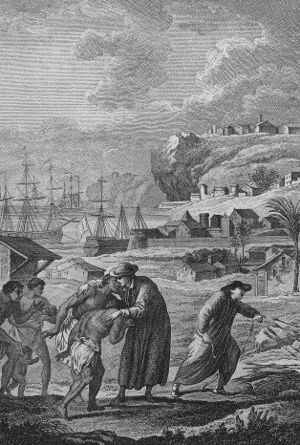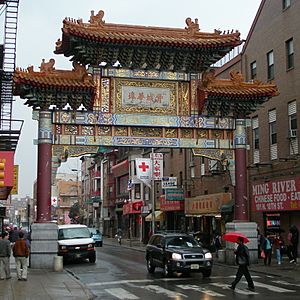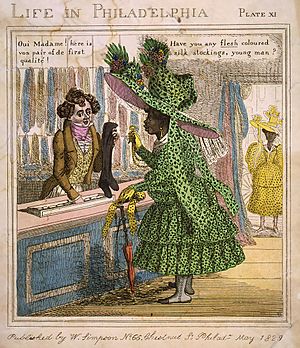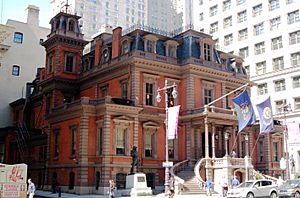Culture of Philadelphia facts for kids
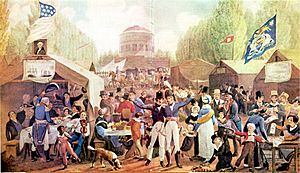
The culture of Philadelphia began in 1682 when Philadelphia, Pennsylvania was founded by William Penn. He wanted Philadelphia to be a place where people could live without fear because of their religion. So, many Quakers, Mennonites, and others came to find safety in the city. As Philadelphia grew into a big political and economic center, many different religious and ethnic groups moved there. In the 1800s and 1900s, large numbers of Irish, Italians, Germans, Asians, Puerto Ricans, and African Americans arrived. Today, Philadelphia is still a major place for new immigrants, including large Chinese, Vietnamese, Korean, East African, Middle Eastern, Indian, and Mexican populations.
Philadelphia's cultural importance has changed over time. The city has made important contributions in art, music, television, architecture, and food. Famous Philadelphia places range from the Philadelphia Museum of Art to Pat's Steaks.
Contents
People of Philadelphia
Before Europeans arrived, the Lenape people lived in the area that became Philadelphia. The Lenape sometimes fought with early Dutch settlers. But they had much better relationships with William Penn and the first English settlers of Pennsylvania. Still, diseases and new towns pushed the Lenape people further west.
William Penn was a Quaker who had faced religious unfairness. He imagined his colony as a place where many different groups could live together and worship freely. Mennonites, Amish, Moravians, and Pietists moved to the area in the 1600s. By the mid-1700s, Quakers and English people became a smaller part of the colony. Other groups like the Welsh, Scots, Finns, African slaves, Irish, and Germans moved to the city. Lutherans built churches as early as the 1720s. In 1734, followers of the Schwenkfelder Church arrived. The first American Presbytery was founded in Philadelphia in 1706. The city's first Catholic chapel was built in 1733. The first recorded Jewish person, Nathan Levy, arrived in 1735.
During most of the 1800s, immigrants mainly from Germany, England, and Ireland settled in the city. Many of these immigrants were Catholic. This led to some anti-Catholic feelings and groups. In the 1840s, Philadelphia became a center for anti-Catholic Protestant groups. This led to serious problems in 1844. However, by the end of the 1800s, Roman Catholics became the largest religious group in Philadelphia. In the late 1800s, immigrants started coming more from Italy, Russia, and Eastern Europe. Italians and Poles helped increase the city's Catholic population. Jewish immigrants, mainly from Poland, Lithuania, and Russia, were the largest new religious group. The city's Jewish population grew from 5,000 in 1881 to 100,000 in 1905. Philadelphia's Italian population changed from 300 in 1870 to 77,000 in 1910. Hungarian and Polish immigrants also settled in the city. In the 1900s, political power began to shift. The city's first Catholic mayor was elected in 1963, and its first Jewish mayor in 1992.
In the second half of the 1800s, immigrants began arriving from Latin America, mainly from Puerto Rico and Cuba. By the end of the 1900s, Puerto Ricans became the largest Latino group in Philadelphia. Starting in the 1950s, many Puerto Ricans settled in North Philadelphia. Immigrants from China founded Chinatown in the 1870s and 1880s. Over the next century, this neighborhood grew into a diverse community with immigrants from many Asian countries. By the 2000s, Philadelphia's two largest Asian groups were the Chinese and Koreans. Philadelphia was the first East Coast city with a Korean community in the 1880s. Early members were often political exiles. Immigration from the Middle East to Philadelphia began in the 1880s, mainly from Lebanon. Starting in the 1960s, immigrants from other Middle Eastern countries, like Syria, the Palestinian territories, and Iraq, moved to the city. Other immigrants from Asia in the late 1900s included Indians, Vietnamese, and Cambodians.
African Americans
The first black people in Philadelphia were slaves. About 1,500 people lived as slaves in the city when slavery was legal. Slaves usually lived in their owners' homes and worked as servants or in shops. An abolition law in 1780 did not free existing slaves right away. But it banned the slave trade in Pennsylvania. It also freed children of slaves born after the law was passed once they reached a certain age. By 1780, about 400 slaves and 800 free black people lived in Philadelphia. Many newly freed slaves and escaped slaves from the South moved to the city. By 1820, the city's African American population was nearly eleven percent. During this time, a former slave named Richard Allen founded the African Methodist Episcopal Church in Philadelphia.
As the African American population grew, some white people became less friendly. African Americans faced attacks during a riot in 1834. Four years later, a state law stopped African Americans from voting. In the late 1800s and early 1900s, many African Americans moved from the Southern United States to Philadelphia. This made Philadelphia have the largest African American population of any northern U.S. city. In 1896, W. E. B. Du Bois studied African Americans in Philadelphia. He found many lived in Center City and West Philadelphia. Many African Americans lived near the rich white families they worked for. There was also a small group of wealthy African Americans. These families were generally separate from the white population and from most other African Americans.
As Philadelphia became more industrial, new factories often refused to hire African Americans. In 1899, W. E. B. Du Bois said that many African Americans in the city struggled financially. Many worked as domestic servants. However, some African Americans owned their own businesses. Others became professionals like doctors and lawyers. In 1884, Christopher J. Perry started The Philadelphia Tribune, a newspaper for African Americans. Factories only began hiring African Americans during World War II. The Philadelphia Police Department first hired African Americans in 1881. In the 1950s, James N. Reaves became the first African American Police Captain. He helped integrate police car teams. During the 1950s and 60s, factories and many white residents left the city. African Americans became the city's largest ethnic group. Most of North Philadelphia, West Philadelphia, Germantown, and parts of South Philadelphia became black neighborhoods. Old working-class neighborhoods faced challenges due to job losses. Starting in the 1970s, African Americans gained more political power in city government. The city's first African American mayor, Wilson Goode, was elected in 1984. At the end of the 1900s, a new wave of immigrants from Africa settled in the city. There are an estimated 55,000 African immigrants in Philadelphia from over thirty different countries.
Philadelphia's Old Families
By the late 1700s, Philadelphia had a group of very old, established families. Many of these families could trace their history back to the first Quaker settlers. What mattered most to this group was a person's family background, not how much money they had. Inherited wealth was seen as better than money earned recently. In the late 1800s, Mark Twain joked that in Philadelphia, people asked "who were his parents." Someone new to wealth could not easily join this group. But their children, if they married into the right families, could create a new family line.
In the 1700s, wealth came from shipping, trade, and real estate. Later generations were still expected to have careers. Acceptable jobs included medicine and law, then insurance, banking, and brokerage. Running the family business was also fine, especially if it involved iron and steel making, coal, or railroads. Beyond their jobs, these elite families wanted to be on important boards. This included business boards like the Pennsylvania Railroad, but also boards for charities, cultural groups, and social clubs.
These old Philadelphia families enjoyed fox hunting, breeding race horses, attending fancy balls, and hosting parties in their large homes. They also joined exclusive clubs like the Schuylkill Fishing Company and the Philadelphia Union League. The old families first lived in mansions in Old City. Over time, they moved west through Center City. By the late 1800s, many moved to large mansions along the Pennsylvania Main Line. This "aristocracy" lasted into the 1900s. But by the end of the century, new wealthy families became more common. By the late 1900s, being part of the upper class was less about ancestry. Organizations like the Union League began to accept some Jews, Catholics, and African Americans.
Art in Philadelphia
Fine Art
Before the American Revolution, wealthy people in Philadelphia started supporting the arts more. They especially wanted portrait paintings. This demand for portraits brought many artists to the city. One artist, William Williams, taught oil painting to another Philadelphia artist, Benjamin West. In 1805, an art collector gave the city many paintings, sculptures, and other artworks. To accept this gift, the city formed the Pennsylvania Academy of the Fine Arts. This Academy is the oldest art school and museum in the United States. It helped many artists become famous. Artists like Charles Willson Peale and William Rush helped start the Academy. Other artists like Thomas Eakins and Henry Ossawa Tanner studied there.
The city's main art museum, the Philadelphia Museum of Art, was founded in 1876. It was created to keep the art exhibits from the Centennial Exposition. The museum has over 225,000 pieces of art. This includes works by Vincent van Gogh, Pablo Picasso, and Marcel Duchamp. Not far from the Museum of Art is the Rodin Museum. This museum, founded in 1929, has the largest collection of Auguste Rodin's work outside France. A new museum is planned nearby for the Barnes Foundation collection. In 1923, Albert C. Barnes was upset that his collection of paintings by Paul Cézanne, Henri Matisse, Pablo Picasso, and Amedeo Modigliani was not well-received in Philadelphia. So, Barnes moved the collection to a building in Merion, Pennsylvania. There, he often refused access to most Philadelphians. In 2002, a controversial decision was made to move the collection to Philadelphia for financial reasons, even though Barnes's will said not to. In 1991, to promote Old City art galleries, the Old City Art Association started First Fridays. On the first Friday of every month, Old City galleries have an open house night together.
Philadelphia has more public art than any other American city. Adding decorative art to Philadelphia buildings started in the 1800s. In 1872, the Fairmount Park Art Association was created. This was the first private group in the U.S. dedicated to putting public art into urban planning. This group is responsible for the art along the Schuylkill River drives. In the late 1950s, the Philadelphia Redevelopment Authority required that at least one percent of construction money be used for fine art. In 1959, a law called the Percent for Art ordinance was created. This was the first for a U.S. city. This program has paid for over 200 pieces of public art. It is managed by the Philadelphia Office of Arts and Culture.
Philadelphia has more murals than any other U.S. city. In 1984, the Department of Recreation started the Mural Arts Program. This program, which grew from the city's Anti-Graffiti Network, aims to make neighborhoods more beautiful. It also gives an outlet for graffiti artists. The Mural Arts Program became independent in 1996. It has funded over 2,300 murals created by professional, staff, and volunteer artists. The program also offers art education and tours of the murals.
Music
Music became a big part of city life in the mid-1700s. Organs started appearing in non-Quaker churches. The city also staged its first opera, The Beggar's Opera. The city's music scene grew in the 1800s with music by William Henry Fry. The Musical Fund Society was founded and began supporting concerts in 1820. This society later led to the Academy of Music in 1857. The Academy now hosts the Philly Pops, the Pennsylvania Ballet, and the Opera Company of Philadelphia.
The Philadelphia Orchestra was founded in 1900. It became very famous in the mid-1900s with conductors Leopold Stokowski and Eugene Ormandy. The orchestra's home was the Academy of Music until the Kimmel Center for the Performing Arts opened in 2001.
Philadelphia developed an early jazz scene. Many future stars, like John Coltrane, came from Philadelphia. In 1952, WFIL-TV started Bandstand. In a few years, it became American Bandstand hosted by Dick Clark. The show's national success led to the rise of local music labels. The 1960s saw the development of Philadelphia soul, led by producers Kenny Gamble and Leon Huff. Later, Philadelphia artists contributed to Hip hop music with artists like DJ Jazzy Jeff, Will Smith, The Roots, and Schoolly D. Philadelphia is also a center for rock music. It has several well-known rock radio stations like WMMR. The city is a top place for rock musicians to perform.
More recently, Philadelphia has been home to many popular independent alternative musicians. Bands like Dr. Dog, The War on Drugs, Kurt Vile, Nothing (band), Philadelphia Slick, Alex G, and Beach Slang all call Philadelphia home.
Performing Arts
In Philadelphia's early history, outside theater groups visited the city. But they faced some resistance from conservatives and Quakers who tried to limit performances. The Southwark Theater opened in 1766, marking a permanent theater presence in Philadelphia. Theater shows were banned during the American Revolution. But when the ban was lifted in 1784, theater returned. Another theater, the Chestnut Street Theater, opened ten years later. Over the next century, more theaters opened, including the Walnut Street Theatre and the Forrest Theater. Philadelphia produced several major theater actors, like Edwin Forrest and members of the Barrymore family.
The Philadelphia Theatre Company, founded in 1974, focuses on new American plays. It moved into the Suzanne Roberts Theatre in 2007. Other modern theaters include the Arden Theater Company, the Wilma Theater, and the Lantern Theater Company. The University of Pennsylvania puts on shows at the Annenberg Center for the Performing Arts. African American themed plays are performed at the Freedom Theater and the Bushfire Theater. Every year, the Philadelphia Shakespeare Festival performs three Shakespeare plays.
There are about 120 theater groups in the Philadelphia area. The Theatre Alliance of Greater Philadelphia was formed in 1990 to promote local theater. Since 1994, this group has given out the annual Barrymore Awards for Excellence in Theater to local theater productions.
Dance became a part of Philadelphia with the start of the Philadelphia Dancing Assemblies in 1748. These remained popular into the 1900s. Major dance groups include the Pennsylvania Ballet, founded in 1963. The Pennsylvania Ballet performs at the Academy of Music. The Philadelphia Dance Company (Phildanco) was founded in 1970 and specializes in modern dance. The Koresh Dance Company was formed in 1991. It performs dances that mix elements of ballet, jazz, modern dance, and other dance forms.
Film and Television
On December 18, 1895, Charles Francis Jenkins showed his film projector at the Franklin Institute. It was the first time moving pictures using flexible film were shown in Philadelphia. A week later, Woodville Latham's eidoloscope was shown. A German immigrant and optician, Siegmund Lubin, was impressed. He bought Jenkins' camera. In Philadelphia, he filmed his first movie, his horse eating hay. Lubin continued to make films in Philadelphia and built his own cameras and projectors. He eventually created a production company, Lubin Manufacturing Company, in 1902. Soon after, Lubin opened some of the city's first movie theaters. In 1905, Jules Mastbaum opened the city's first Nickelodeon.
Lubin Studios closed in 1917. For most of the 1900s, Philadelphia had almost no film industry. In 1985, the Greater Philadelphia Film Office was created. Since 1992, this office has helped make over 200 films and television shows. Between 1992 and 2002, film productions brought $500 million to the city's economy. In 2007, MovieMaker Magazine named Philadelphia the second-best American city to make a movie in. The magazine mentioned local talent, cost of living, and help from the Film Office as reasons. Every year, Philadelphia hosts the Philadelphia Film Festival and the Philadelphia International Gay & Lesbian Film Festival. The Philadelphia Asian American Film Festival started in October 2008.
In the early 1930s, Philco Corp. started Philadelphia's first experimental television station, W3XE. That station became NBC's first affiliate in 1939. In 1941, it became WPTZ-TV after getting Philadelphia's first commercial license. By the late 1940s, WPTZ was joined by WCAU-TV and WFIL-TV, now WPVI-TV. Later, WHYY-TV, WPHL-TV, WTXF-TV, and WPSG-TV joined the Philadelphia market. According to Nielsen Media Research, Philadelphia has the fourth largest media market in the U.S. Major shows broadcast from Philadelphia include American Bandstand, Double Dare, and The Mike Douglas Show.
Food in Philadelphia
Philadelphia is home to many famous foods, both fancy and local favorites. The city's history of immigrants has allowed many different tastes to mix and grow. The cheesesteak, created in Philadelphia in the 1930s, is a well-known city icon. A popular Philadelphia debate is which of two cheesesteak rivals has the best steaks: Pat's Steaks, which invented the cheesesteak, or Geno's Steaks. Italian ice (often called "water ice" in Philadelphia) and soft pretzels were not invented in Philadelphia. But they have become Philadelphia favorites because they are so popular and easy to find. Irish potato candy is a popular Philadelphia candy that is especially popular around St. Patrick's Day.
During the 1700s, city taverns like the London Coffee House and Tun Tavern were regular meeting places for political and business leaders. Another tavern often visited by politicians is McGillin's Olde Ale House, which is the oldest continuously open tavern in the city. In the late 1800s, two Philadelphia landmarks were created: the Reading Terminal Market and Italian Market. These markets sell all types of food and other goods. The early 1900s saw the creation of the first automat in the United States on Chestnut Street. It also saw the founding of the Tasty Baking Company. For most of the 1900s, fancy dining was mostly found in private clubs. But with the city's comeback in the 1970s, a restaurant boom began. Starting with Le Bec-Fin in 1970, many upscale restaurants have opened in popular neighborhoods. Philadelphia has since added over 150 fine dining places. This includes several trendy restaurants by Stephen Starr, as well as many sidewalk cafes and bars. This boom has led to Philadelphia being called a world-class "food city."
Philadelphia's large Chinese, Vietnamese, and East African populations have greatly influenced its dining scene. Philly Chinatown has excellent Chinese, Vietnamese, Thai, and Malaysian foods. South Philly has many Vietnamese and Chinese restaurants. West Philly is home to several East African restaurants, including four Ethiopian restaurants. Philadelphia also has many Indian and Middle-Eastern restaurants in Center City and West Philly.
Local Culture
Not every Philadelphian eats out or goes to the theater. But most Philadelphians take part in local community activities and groups. Block parties and yard sales are common on weekends. Philadelphia has lively local markets, like the biweekly market in Clark Park at 43rd and Baltimore. Here, local farmers sell produce, and artists and antique collectors show their items. Philadelphia is also home to food cooperatives like West Philly's Mariposa.
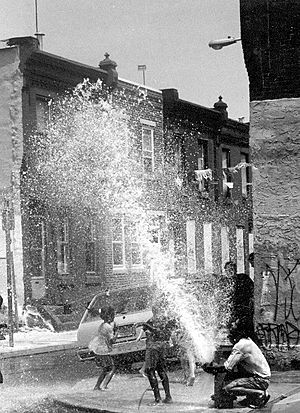
Caring for the environment and keeping local connections are important to many Philadelphia communities.
Philadelphia has a long history of graffiti culture.
Philadelphia has many successful non-profit organizations that help the community. Books Through Bars, which collects books to give to prisons, started in Philadelphia.
Annual Events
Philadelphia holds many annual festivals and events. One of the most famous is the Mummers Parade. The first modern version of the parade was held in 1901. It is held every year on New Year's Day. The Saint Patrick's Day Parade is popular with the city's large Irish population. It is the second oldest parade in the United States. There is also the annual Puerto Rican Day Parade, held in the city for over 50 years. Since 1993, every summer around the July 4th holiday, the multi-day Welcome America event celebrates Philadelphia as the birthplace of the United States. Three major annual shows in Philadelphia are the Philadelphia Flower Show in March, the Philadelphia International Auto Show in February, and the Philadelphia Antiques Show in April.
Major events include the Greek Picnic, a reunion and celebration for African American college fraternities and sororities. Another event, the Wing Bowl, is an eating contest started in 1993. Festivals include the Philadelphia Folk Festival and Unity Day, an event celebrating unity among people and families. PrideFest events promote LGBT rights. In September, the 16-day Philadelphia Live Arts Festival and Philly Fringe highlights experimental art, performances, and exhibits throughout the city.
Philadelphia in Stories
The city has been featured in books, movies, and television shows. One of the first novels set in Philadelphia was The Quaker City, or The Monks of Monk Hall by George Lippard in 1845. This novel sold 60,000 copies in less than a year. Other novels set in the city include John Edgar Wideman's Philadelphia Fire: A Novel, the Old Philadelphia Mystery book series, and Jonathan Franzen's The Corrections. The 2006 book Philly Fiction included 19 short stories set in Philadelphia by modern authors.
Among Philadelphia's most famous films is Rocky, which was filmed mostly in the city. Others include Philadelphia, a film about AIDS discrimination. There are also two films set in the city's 1930s high society: The Philadelphia Story and Kitty Foyle. Filmmaker M. Night Shyamalan has set many of his films in or around Philadelphia, including The Sixth Sense and Unbreakable. Television shows that take place in Philadelphia include thirtysomething, Boy Meets World, Cold Case, Hack, The Class, and It's Always Sunny in Philadelphia.
Images for kids
-
Philadelphia Union League, May 2017


